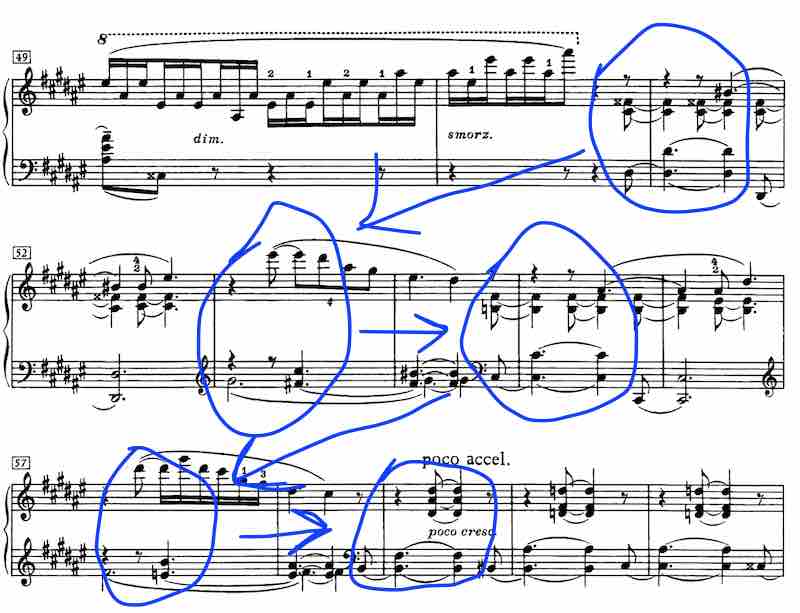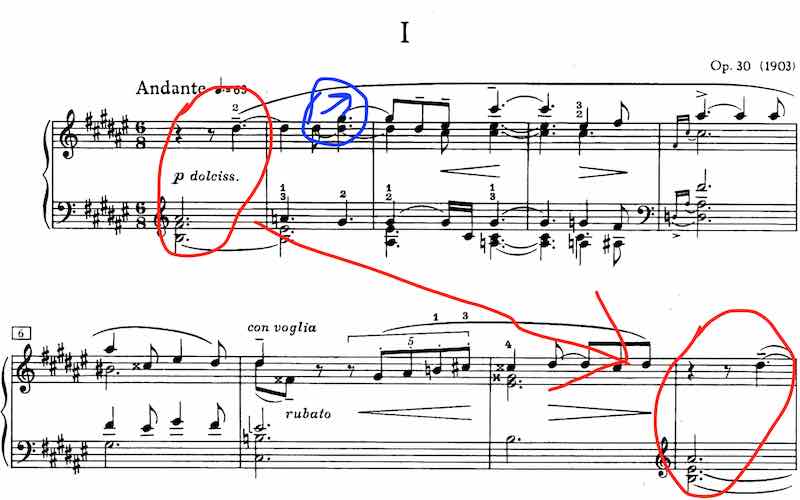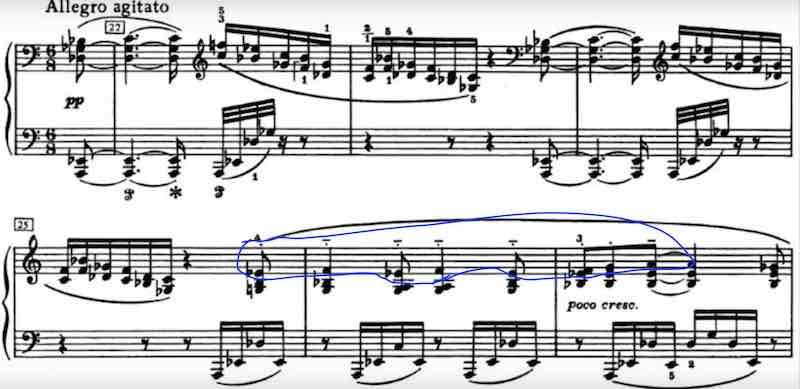Before I start
In this blog post, I would like to write about the life and work of the famous Russian composer Alexander (Nikolaevich) Scriabin.
More specifically, I will outline his periods, throughout which, his journey as a composer has led him, during his life.
I will choose three works of Scriabin, each from each period and while comparing them outline the changes in the harmonic language of Scriabin.
Let me start with a short introduction about A. Scriabin.
Introduction
So who exactly was Scriabin? A. Scriabin was and still is, for us, as his admirers, a Russian pianist and composer.
He was born on January 6th 1872 and died on April 27th 1915. Not only is Scriabin an highly interesting composer, he is also a very eccentric person, as he employed his own philosophy and had his views of the world.
Hence, Scriabin was influenced by synesthesia, meaning he associated tones and tonalities with colours. He had even a colour-coded version of the circle of fifth.
This is noticeable especially in his later works, all of which carry a deeply mystical and symbolic meaning.
Also, Scriabin was highly interested in philosophy, ranging from the “Übermensch” philosophy by Nietzsche to the esoteric and somewhat mystical world of Helena Blavatskaya. This is mirrored very clearly in his music.
Scriabin did write the majority of his works for piano, as opposed to orchestral pieces (among some famous, his Symphonies, Poem of Ecstasy, Prometheus and his only piano concerto). Hence, I will pick piano pieces for the analysis of his periods, which shaped Scriabin as a composer.
The styles of Scriabin
Early in his life, Scriabin was influenced strongly by the style of Frederic Chopin.
Along harmonic features, which I will outline later in this blog post, Scriabin was inspired by the form and idea of the piano Prelude, which he himself used extensively.
By the way, according to the biography of Scriabin by Sabaneev, the fascination with Chopin, faded with time away. Intrestingly enough, especially in his last years, Scriabin didn’t really have composers whom he admired.
Also, it should be noted, that his early music is still highly tonal. It is only later in his career, that he developed an atonal and dissonant musical system, that is fully aligned with his personal world views, as mysticism.
Interestingly enough, in contrary to composers like Stravinsky, Scriabin developed his approach to atonality completely independently as compared to the second Viennese school, led by A. Schönberg. While and after this transition he always maintained a style, which very clearly belongs to Scriabin.
This are the reasons the music of Scriabin leads to completely different worlds, as there are no composers quite like him.
The compositions of Scriabin, throughout his lifetime can be placed in approximately 3 periods:
-
The first period, ranging from his first works to approximately Op.29, from the 1880s to 1903
-
The seconds period, ranging from his fourth sonata (Op.30) to the Poem of Ecstasy (Op.54), from 1903 to 1907
-
The third period, including all of his later works, noticeably his later piano sonata’s, from 1907-1915
The first period of Scriabin
Scriabin’s compositions from the first period, still adhere very much to the romantic traditions, inspired strongly by Frederic Chopin and Franz Liszt.
Scriabin still uses traditional harmony, however his interest in the dominant 7th chord is clearly noticeable, as he uses it very often, especially together with tones such as the 9th, raised 11th, altered 5th and 13th.
Also, he often stacks 4th on top op each other, as will be clear in the next examples, to build those chords, which sounds in a sense already very modern. However, Scriabin still deals with those dominant chord in a traditional way.
This means that Scriabin still solves the chord “correctly” and respects the dominant function of the chord. This results in a very clearly perceivable tonality.
As a representation of the first period of A.Scriabin I have chosen the Etude Op.8 No.12 in d sharp minor.
This piece perfectly represents the deeply romantic soul of Scriabin, with typically Chopin-esque elements and spirit. In a sense, it is quite similar to the Chopin Etude Op.10 No.12 as it also features a very heroic, yet deeply soulful melody, which, paired together with the forceful accompaniment makes listening to this piece a very dramatic experience.
Also, the figuration of tuplets, which are appearing simultaneously (such as 2 against 3 or 3 against 4), is very typical for Scriabin, and only become more elaborate, physically as well as musically, in the later works of Scriabin.

First bars of the Etude Op.8 No.12 by Scriabin
Is it already the beginning of the famous Scriabin rhythms, the highly erratic and unstable pulse?
Personally, it is for these reasons that I love this piece very much, and have chosen it for this paper, as a representation of the first period by Scriabin.
The second period of Scriabin
The second period begins with the fourth sonata by Scriabin (Op.30), which is, probably, one of my favourite works by Scriabin.
I think, that the fourth Sonata Op.30 by Scriabin is a perfect representation of the second period of Scriabin, because it is very clearly visible that, although Scriabin maintains adhesion to traditional tonality, he starts to become more chromatic and dissonant.
He makes great use of (cleverly hidden) falling fifth sequences, tritone substitutions (although this term comes from Jazz, I think it is a great way to explain the harmonic movements Scriabin often uses) and third relations.

Example of chromaticism in the 2nd movement in the fourth Sonata Op.30 by Scriabin.

Example of a falling fifth sequence (soo beautiful) in the end of the 1st movement in the fourth Sonata Op.30 by Scriabin.
For example, the first movement of the Sonata Op.30 No.4 in F-sharp minor by Scriabin, is almost completely build on dominant 7th chords, that are build in a way I described before: Often Scriabin stacks 4th or tritones on top of each other (and uses “colour tones”, such as the 9th, 13th etc.), and creates an amazing sound effect.
A beautiful example is the beginning of the Sonata, it begins with a Major 7th chords on the 4th grade (B major 7th chord), which is already unusual for a tonal piece, in a very beautiful voicing (root, 5th, 7th, 3rd). Directly in the second sentence this chord is “converted” into a dominant chord (there are many ways to interpret this chord), as a tritone appears:

The beginning of the fourth Sonata Op.30 by Scriabin.
Throughout the whole piece these dominant chords constantly solve into each other, which creates a very interesting musical effect, of a constant search, as there is almost never a place, where the music comes to a clear tonic.
Also, this piece already contains a lot of symbolic elements, that are frequently used by Scriabin, for example the important role of the ascending 4th in the melody. By the way, it is in the Poem of Ecstasy that the ascending 4th plays a very central role (but that’s worth a separate blog post).
One last thing to mention about the “Scriabin-style” is his use of highly erratic and difficult rhythms, that only become more elaborate in his later works (such as the infamous 9th Sonata). In the second movement of the 4th sonata you can clearly see swing-rhythm (which existed before swing was even invented).
For me, Scriabin’s 4th sonata is a constant search for something very high and abstract, perhaps a star, vision or desire, something ecstatic; it is constantly reaching higher and higher. I cannot reiterate enough of how much I love this piece.
The third period of Scriabin
In the third period, Scriabin very clearly abandons tonality. However, in contrast to serial composers like Schönberg, there still remains an tonal afterthought. Hence, most works from this period are composed using acoustic and octatonic scales.
This way the mystic chord of Scriabin can be explained too: As an representation of the overtone series (although, in the biography by Sabaneev it is clearly stated, that Scriabin found his harmonies in a purely intuitive way, which also aligned with his philosophies).
By the way, I can only recommend reading the book by Sabaneev, if you are really interested in Scriabin as a composer but also as a human being!
This also explains Scriabin’s “obsession” with dominant 7th chords, that I described earlier, as the dominant 7th chord is by nature a result of the overtone series.
But most importantly, in the third period, Scriabin uses a wide variety of symbolic links as he started to do in his 2nd period, with third relations linked to colours (his interpretation) in the circle of fifth. Each chord has a deep meaning and intention.
A beautiful example of Scriabin’s third period is the 8th sonata. Even though it “feels” quite tonal, there is absolutely no tonality. However, the piece still has meaning.
In contrast to the 4th sonata, which I mentioned above, the 8th sonata is incredibly dark and mystical. Here is the beginning of the 2nd movement, you can clearly see the use of the octatonic scale.

The beginning of the 2nd movement of the 8th Sonata by Scriabin
By the way, this piece seems technically extremely difficult, it is, probably one of the most difficult, complex and elaborate pieces by Scriabin.
This Sonata indeed abandons any adhesion to traditional harmonies and tonality. Vertical, chordal harmonies work in unison with horizontal lines (like the octatonic element), which create an incredibly tense effect.
Scriabin even went as far as writing poems that describe his pieces. This is incredibly interesting.
Conclusion
It is absolutely fair to say, that Scriabin is a very special composer, and there are no composers quite like him. Scriabin has indeed created his own world, and his music allows us to be submerged in this very special, mystical world.
This blog post, was only a very short and shallow look into the world of Scriabin. There are still a lot of interesting moments about this composer, that are waiting to be described by someone.
But we’ll get there, eventually:)

